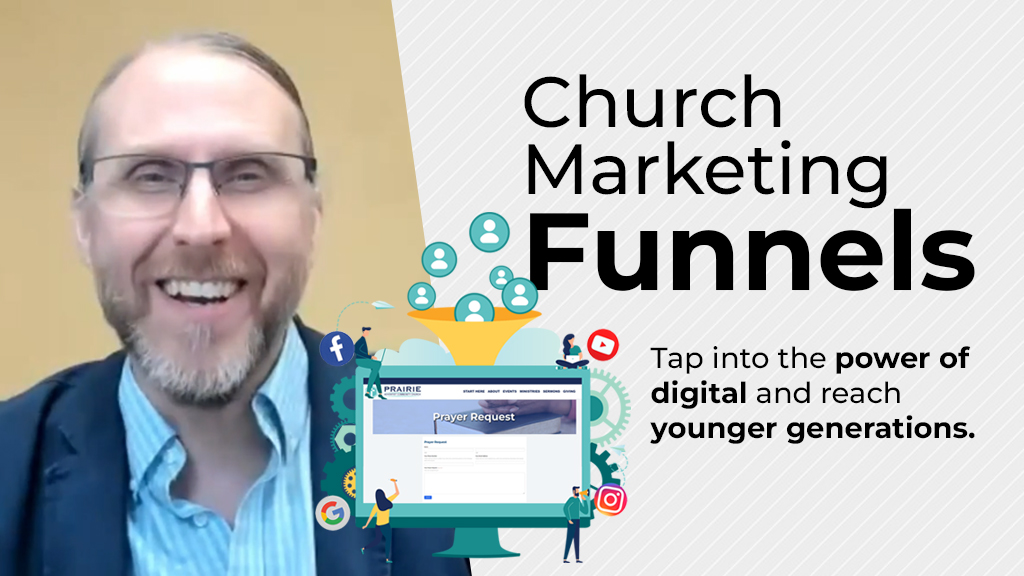Technology has changed how we interact with the physical world. Yet despite all of the technological advances, people still need human connection. So how do you create connections and build trust in a society that has less and less experience with church?
By meeting people right where they are: online.
In this webinar, SermonView founder and president Larry Witzel will explore essential digital marketing strategies such as search engine marketing, targeted social media ads, engaging social posts, impactful YouTube advertising, and consistent email communication.
We delved into the power of leveraging doctrine and felt-need-based content to resonate with your audience, fostering meaningful connections and guiding them along their spiritual journey. Additionally, we uncovered the potential of remarketing strategies to re-engage individuals who have visited your website, ensuring sustained outreach and impact. It’s a new way to transform your church’s digital presence and effectively engage with those seeking spiritual connection and growth in today’s digital age.
In less than an hour, you’ll discover innovative methods for digital outreach and community building that align with the unique mission and teachings of your church.
Welcome to today’s webinar! We’ll be talking about church marketing funnels, what they are, and how to use them evangelistically. My goal for today is that you leave with something practical that you can put into use this week in your ministry.
Before we get to what a funnel is and how its used in e-commerce, let’s talk about our goal for using this tool. Our goal is in-person relationship. We want people to connect with your church in a physically present way. Your church offers connection to a spiritual community, relationships with other believers. God created humans with the innate need to belong to community, and church exists to fulfill this fundamental need to belong. We are social creatures, and although church of course has a theological component, and a vertical relationship with God, church is fundamentally a social experience, with horizontal relationships between humans. And the most powerful social relationships exist when people are physically with each other.
So our goal is in-person community. People today, especially younger generations, live much of their lives in the digital space, and research is showing that this digital engagement is actually driving loneliness, anxiety, and depression. People today crave in-person experiences and real, life-giving community. We’re going to use digital communication technologies to reach people where they are, online, but our goal is to progressively move them toward an in-person relationship. The digital transformation allows us to accelerate this relationship-building through digital media. It allows us to break through the social anxiety to connect with people right where they’re at. It allows us to get out of the church building and begin developing relationships with people in the community. When the time is right, we can then invite these people to an in-person experience where that relationship can be deepened.
So our goal is in-person, face-to-face interactions with you and other church members.
What is a Funnel?
In the context of marketing and online engagement, the funnel is a model used to represent a customer’s journey from first learning about a product or service to taking the action we desire, such as making a purchase. It’s called a funnel because of its shape, wide at the top and narrow at the bottom. This shape represents the gradual decrease in the number of people at each stage of the process as potential leads are filtered through different stages of engagement. Only a fraction move on to the next stage.
Here’s a general model of the marketing funnel:

Awareness: In e-commerce, you want to attract as many people as possible to your website, using a variety of techniques: search engine optimization, social media advertising, content marketing, and search engine ad campaigns to generate traffic. When someone clicks through to your website from one of these sources, they’ve completed the awareness stage.
Interest: This is where you engage your website visitors by showcasing the value of your product or service. Provide detailed product information, attractive images, compelling product descriptions, and customer reviews to help visitors understand the product.
Consideration: In this stage, you encourage visitors to consider the product as a solution to their needs. Offer comparisons with similar products, show testimonials or case studies, and provide detailed benefits or unique selling propositions (USPs) of the products. When a user adds a product to the shopping cart, they’ve completed the consideration stage
Conversion: This is where you convert interested visitors into buyers. Here an online marketer will work to streamline the checkout process, offer multiple payment options, and provide clear calls-to-action. Sometimes they will implement strategies like offering limited-time discounts, free shipping, or using urgency (e.g., “Only 2 left in stock!”) to encourage immediate purchase.
Retention: In this stage, you work to turn one-time buyers into repeat customers. Marketers do this by engaging customers after the purchase with follow-up emails, solicit feedback, offer customer support, encourage them to join loyalty programs, and provide them with special offers or recommendations based on past purchases.
Advocacy: Beyond just being repeat customers, you want satisfied customers to become brand advocates. You want them to be raving fans. Here a marketer will implement referral programs, encourage social media sharing, and make it easy for customers to leave reviews or testimonials.
Online marketers work hard to optimize each stage of the funnel, guiding potential customers through their buying journey.
This results in higher conversion rates and customer loyalty. The funnel not only helps in targeting the right audience with the right message at the right time but also in allocating marketing resources efficiently. So for example, if we see that there’s a big drop-off between the Consideration and Conversion stages, we’ll look at what’s going on and in this case, how can we make it easier to help the potential customer add the product into the shopping card.
Today, the top funnel experts say you want to be tightly focused on a single product or service. So if someone searches for webcam, for example, they should come to a landing page specifically about a webcam that you offer. Help them focus on that single product. Ideally, you’ll avoid distractions by removing links to other parts of your website.
Let me give you an example. Here is an ad in my Facebook feed for a webcam from a company called iContactCamera.
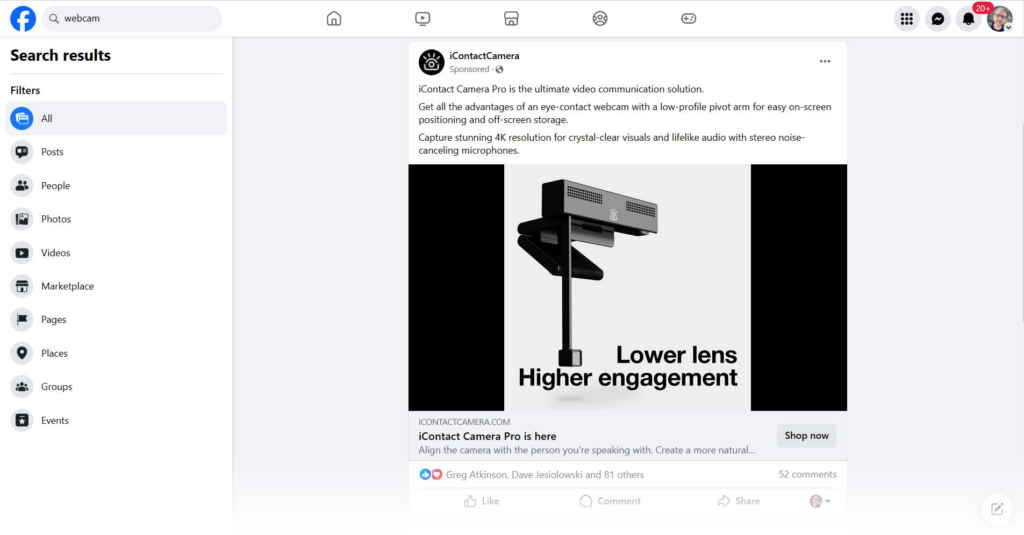
It’s a webcam that puts the camera down into the middle of the screen, so when you’re looking at the screen you’re also looking at the camera. And this is a 4K version with a better quality camera. I’m in the awareness stage, where I’m being introduced to this for the first time. This looks interesting, so I want to learn more about it.
When I click the ad it sends me to their website, where I can learn more about this camera. I’m now in the interest stage.
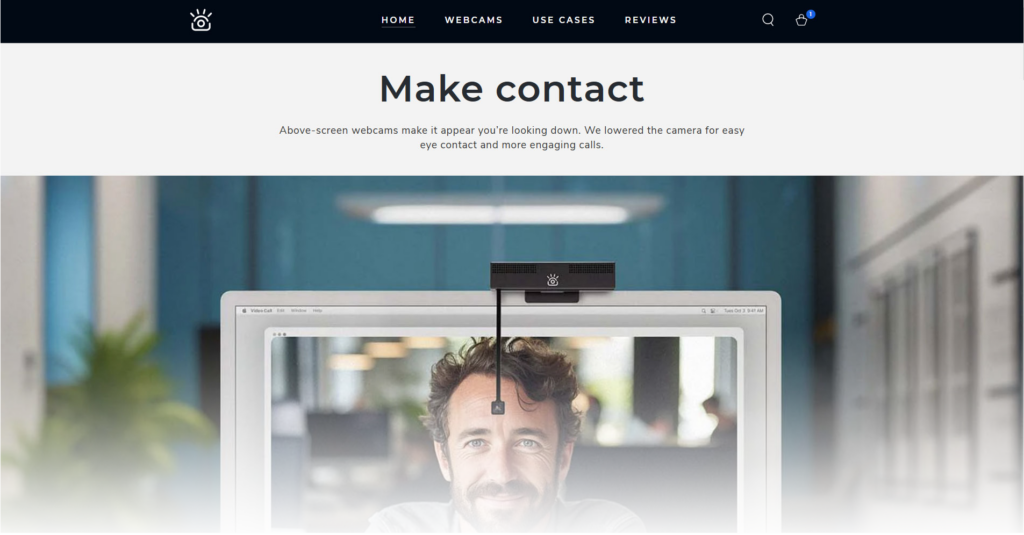
They’ve got information about their value proposition and the benefits you get from using this particular webcam. As I learn more about it, I move from the interest to the consideration stage, where now I’m actually thinking about buying the camera. When I click the add to cart button, I’m now in the conversion stage, where they do things to help me complete the checkout process and actually make the purchase.
If I click “Pay Now”, I will move to the retention stage of the funnel, where I assume I’ll get an email with information about the purchase. After the product arrives, they’ll probably contact me again to see how the camera is working for me and ensure I’m satisfied with the purchase. In this case, there may not be an opportunity for me to become a repeat customer, because of the type of product, but I could become an advocate, telling people about the product. And they have tools to make that easy, like a share button.
So that’s how e-commerce companies use the marketing funnel.
Why a funnel works
Before we talk about how to apply this online funnel to local church evangelism, I want to briefly look at the psychology of funnels. In my PhD studies I ran across work by Dr. Robert Cialdini, an American psychologist who developed a framework for understanding how to influence people to take a specific action. He described 6 principles for influence. We don’t have time to go through all of them, but his book Influence: The Psychology of Persuasion is a New York Times bestseller with over 5 million copies sold. Now, full disclosure, I haven’t actually read this book yet. I bought it, but I’ve looked at more of his academic research.
I want to focus on just two of his principles. The first he calls Reciprocity, which suggests that when someone is given something of value, they want to return something of equivalent value. We’ll use that when we offer something for free. The second is what he calls Consistency. This principle suggests that people like to be consistent in terms of attitudes, beliefs, and behaviors. This is similar to the idea of cognitive dissonance that we’ve talked about on a previous webinar, but flipped around.
Here’s the key: if you ask someone to take an action that is consistent with established behaviors, with what they’ve done in the past, they are more likely to do what you ask.
Also, if the individual has voluntarily and publicly declared a commitment to something, they are more likely to follow through. That’s the psychological principle of consistency. Once people commit to something, they are more likely to go through with it to maintain a self-image of consistency and reliability. In the context of online marketing funnels, this principle can be leveraged to guide potential customers from initial interest to final purchase and beyond.
So for example, in the Awareness stage you ask for a low-risk and non-binding commitment, like signing up for a newsletter, or following a social media account, or downloading a free ebook. These small commitments are designed to start building a relationship. When users take this initial step, they begin to see themselves as someone who is interested in your brand or products, setting the stage for further engagement.
As potential customers move through the interest and consideration stages of the funnel, they are encouraged to make more significant commitments. This could be engaging with content, participating in a free trial, or adding items to a cart. Each step is designed to reinforce the customer’s self-image as someone who is interested in and supportive of the brand. People are more likely to continue a behavior if they see it as consistent with their self-image and past actions.
In the conversation stage, the potential customer is asked to make a more significant commitment: actually making the purchase. If the previous stages have effectively reinforced the customer’s commitment, making a purchase is seen as the natural next step in maintaining a consistent pattern of behavior. Techniques like highlighting the customer’s previous engagements or choices (e.g., “You’ve already chosen the perfect color, just one step away from enjoying your new product!”) can be effective.
Then after the purchase, the focus shifts to retaining the customer and encouraging them to advocate for the brand. Customers who have made a purchase are reminded of their positive choice and are encouraged to remain consistent with that choice by repurchasing, subscribing, or recommending the brand to others. Testimonials, loyalty programs, and referral incentives can play a significant role at this stage.
As you can see, this psychological principle of consistency is the basis for effective funnels. Small commitments lead toward bigger commitments, ultimately leading to a purchase, and then to advocacy for the brand.
Funnels in the church
Okay, so how does a church use this concept of a marketing funnel? Well, if you’ve spent any time around Adventist evangelism you know that we already use these principles in evangelism. An evangelistic series is essentially an evangelistic funnel, where we move people through a sequence of decisions until it’s easy for them to say, yes, I want to be a member of the remnant church.
Here at SermonView, we use the funnel principles when we do evangelism marketing. We send out direct mail and use social media advertising to make people aware of the meetings. That’s the awareness stage. We send them to a website where they can learn more. That’s the interest stage. We invite them to reserve seats, which is the consideration stage, but pre-registration is obviously not the final step here. We want them to show up on opening night. So we send reminder emails and text messages, and when they walk through the church doors on opening night, we’ve reached the conversion stage of the marketing funnel. That’s how we use it as an evangelism marketing company.

But what I want to talk about today is how your church can use this marketing funnel every day, all year long. You’ll use it not just for one-time events, but for year-round ministry.
Here’s how we’ll do it. We’ll start by running some Google ads for specific keywords related to various doctrinal and felt-need topics, targeted to the area around your church, so when people search on Google in your geographic area they’ll see an ad for that topic. We’ll also run social media ads, YouTube ads, and make social media posts on this topic. That’s the awareness phase.
When they click through, they go to a page on that specific topic, where they can learn more. They’re now in the interest stage. We put a video on that page and a short article where their curiosity is piqued further. We also put a form on the page where they can request a Bible study guide on this specific topic. When they fill out that form, they’re in the consideration stage.
Once we have their contact information, we can text and email them afterwards, checking in on how the Bible study went. These emails can also invite them to an in-person Bible study on this topic. We send a message immediately, to help them remember they made this request. Then we send another message every 3 or 4 days for a couple of weeks, then we move them to once a week. These messages begin to broaden the focus beyond that particular doctrinal topic to other things your church offers. You offer something of value in each email, so brief devotional thought or inspirational message, and you invite them to an in-person event. That could be a Sabbath School, or the worship service, or some other event specifically designed for guests.
Here’s the thing: you want there to be a page where they can “register” for the event, whatever it is. When they fill out that form, they’re now in the conversion stage. You’ll send them a follow up email and text saying, “We’re so excited to see you at this event! When you arrive, be sure to ask for [your name], and I’ll be your personal host for this experience. I’m looking forward to meeting you!”
When they show up for the event, they’re now in the retention stage. What can you do to create an experience where they want to come back? Once you’re meeting with them in person, we’re done with the digital marketing funnel, and now you’re just doing ministry in your church.
Let’s go through the specific components to making this work. I’m going to start with the landing page, which is NOT the first stage, right? This is the interest stage of the marketing funnel.
Interest: Landing Pages
The topic for this funnel is Sabbath rest. So here’s a landing page on that specific topic. We have a short, 60-second video on the topic by the pastor, which, by the way, helps to continue fostering a parasocial relationship if you’ve been running YouTube ads. (We’ll come back to that.)
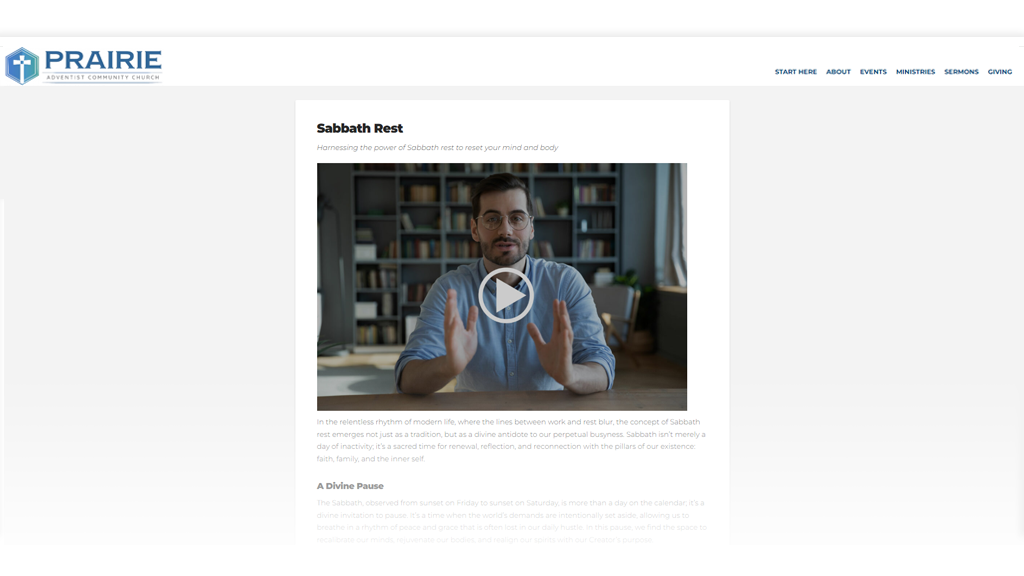
We then have a short, 400-word blog post about Sabbath rest. And at the bottom, we’ve got a form for them to give us information for a free Bible study guide on the Sabbath.
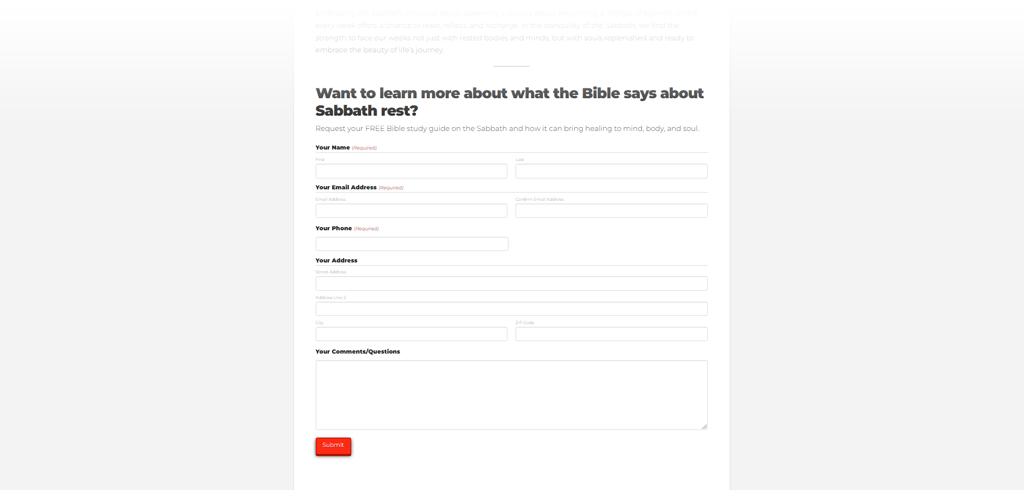
There’s not much to it, and that’s intentional. We don’t share the entire 20th fundamental belief on the Sabbath. It’s very focused on the felt need of rest, and talking about the benefits of Sabbath rest. Then they can contact you to learn more.
Awareness: Ads/Posts
So how do people get to this web page? This is where social posts and advertising come in.
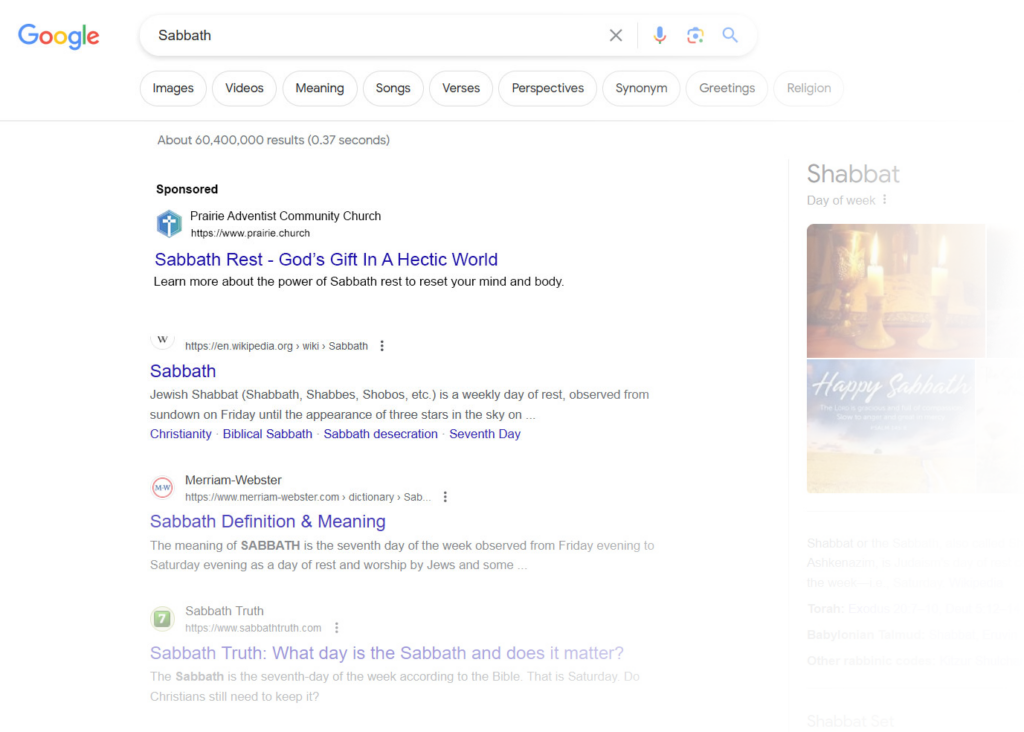
First, you need to run Google ads for Sabbath-related keywords. Here’s an example.
So when someone searches for Sabbath, this ad appears. When they click on it, it goes to the landing page on the Sabbath. This is really inexpensive, and should be running year round. And in fact there are cases where these search ads could actually be free to you as a church.
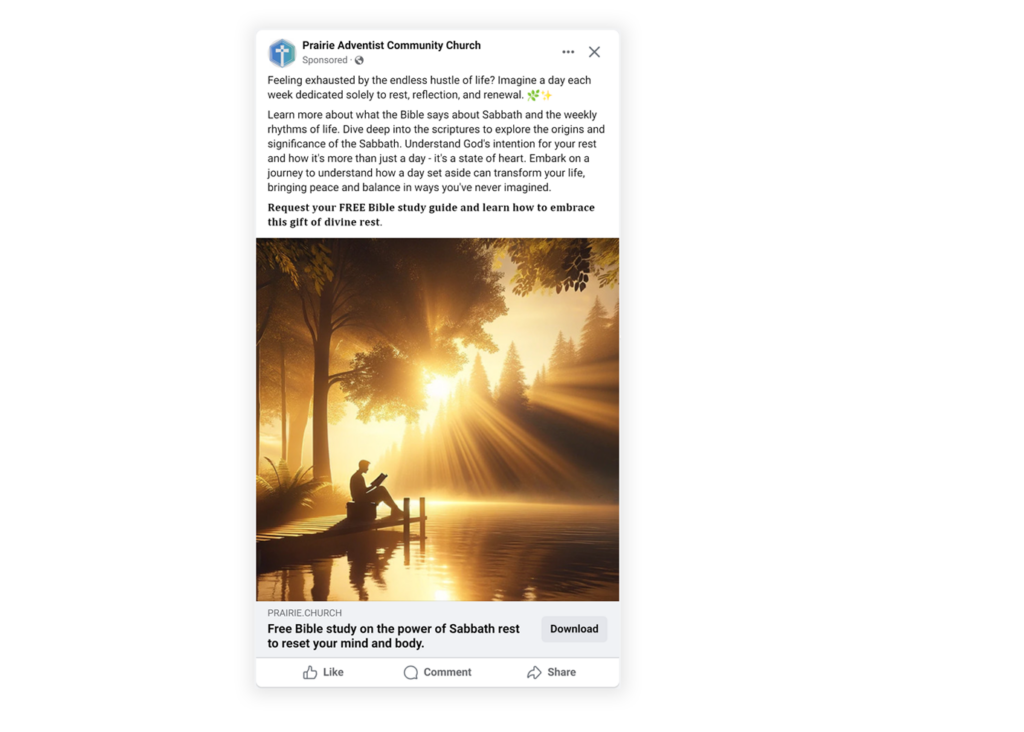
Another thing you can do is run Facebook and Instagram ads.
When you click the link, it goes to that landing page. Now, these won’t run year round. You’ll want to run ads on a particular topic for 3 or 4 weeks, then switch to another topic. So if you have 6 topics you’re focusing on, you can hit each topic twice a year.
(Here’s an example of a Facebook ad on the Sabbath.)
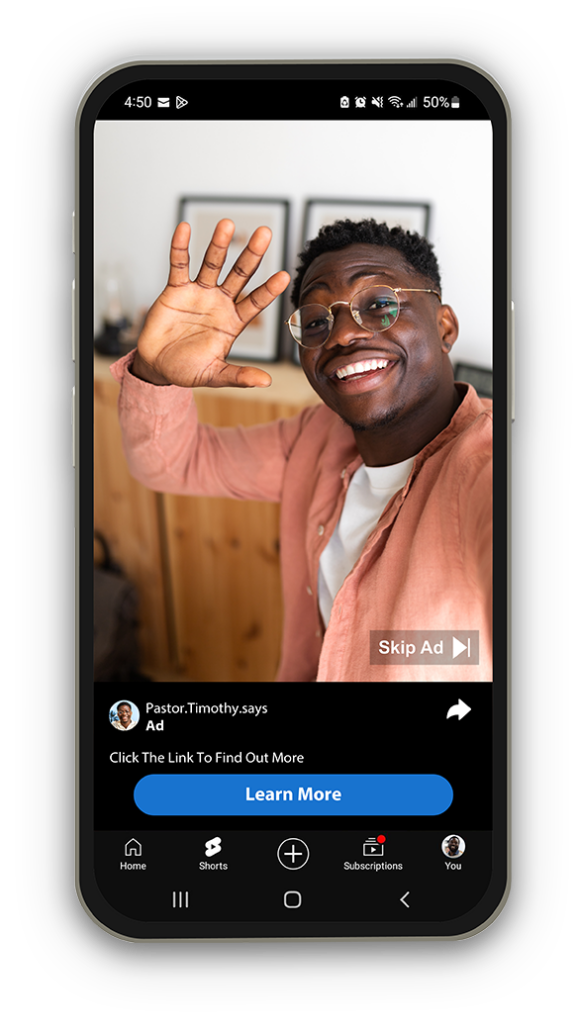
Another way to raise awareness is if you’re doing YouTube advertising. We talked last time about a year-long YouTube program where you run ads on spiritual topics to build parasocial relationships in the community. So if you were doing this, I would do a series of 4 short videos on the power of Sabbath rest. These would then click through to this landing page.
And finally, you can do social posts on the topic. Now, the issue here is that the algorithm tends to display your post only to your followers and, sometimes, people like them. So you’re not going to get very much exposure from these organic social posts. But it doesn’t cost anything, and it doesn’t hurt to do it. So every week, you could do a social post on Sabbath rest. If you have 6 topics, you can do 3 posts every week, which allows you to hit each topic every 2 weeks.
Consideration: Follow-up
Okay, someone saw and ad or a social post, came to the landing page, and requested your offer. How do you follow up?
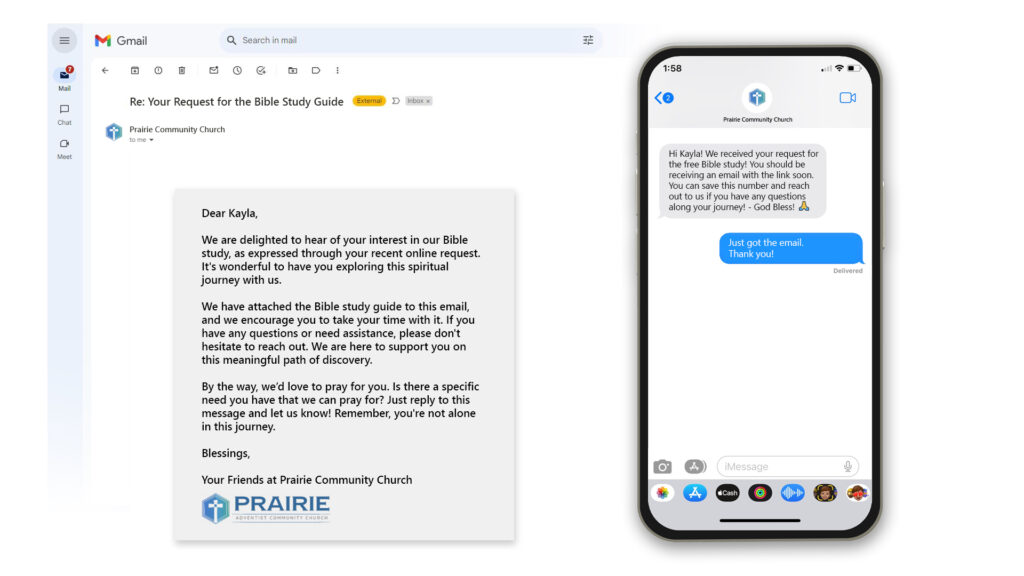
First of all, when someone requests the Bible study from the landing page, they should get an email and a text message immediately. We’re so excited to offer this Bible study guide, we hope you’ll be blessed.
In that message, you could also mentioned prayer. Something like, By the way, we’d love to pray for you. Is there a specific need you have that we can pray for? Just reply to this message and let us know!

3 days later, another message should automatically go out. Just wanted to check in to see how the Bible study was? Let us know if you have any questions. By the way, we have an in-person Bible study that is happening this Saturday morning at 10:00, where we’ll be getting deeper into the Bible on the topic of the Sabbath. We’d love for you to join us! Click here to let us know you’ll be coming.
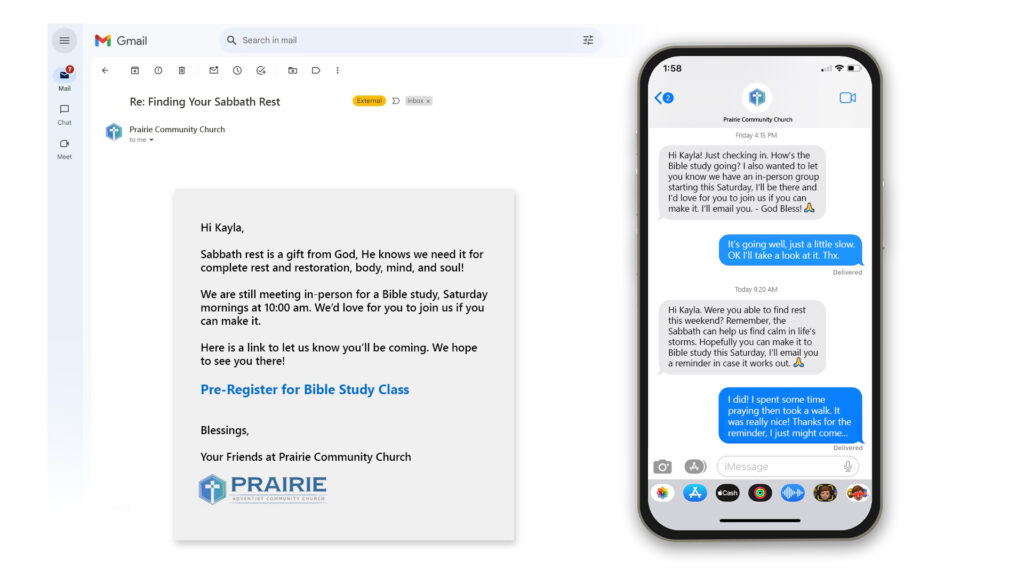
4 days later, send another email with a short paragraph about the Sabbath, and invite them again to an in-person Bible study on Saturday morning.
Then, every week after that, invite them to the Bible study, with a link to reserve their spot.
Conversion: Register to attend
So here’s an example of a page for registering for the class. We’ve got another video from the pastor, along with some basic information about the class and a form to register.
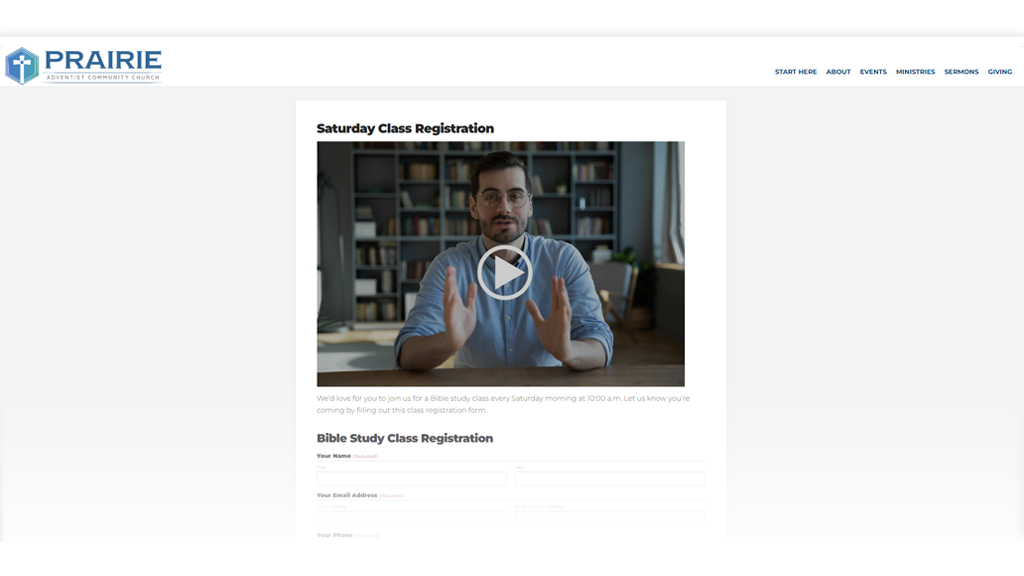
Now, why are we asking someone to reserve a spot to come to Sabbath School? Do you really need to know how many guests have registered? Of course not. (If a bunch of people showed up, you’d grab more chairs and make it work, right?) This isn’t about capacity planning. And we already have their information, since these emails and text messages come after they’ve requested the Bible study guide. Yes, it’s nice to know that a guest is planning to come, so you can be in the right mindset to meet them, but even that’s not the fundamental reason for asking them to register.
So why do it? Two reasons. First, remember Cialdini’s principle of consistency. We’re asking them to make another small commitment prior to them coming, because that increases the likelihood of them actually coming.
Second, now we can send them reminders about the event.

Similar to requesting a Bible study guide, as soon as they register send them an email and a text. Say something like, we’re saving your seat at the Bible study on Saturday, and we’re so excited to meet you! Remind them of what they signed up for: an in-person Bible study group. And tell them, when you arrive be sure to ask for me, so I can be your personal host on Saturday morning. Affirm them for making the right decision, and warmly welcome them.

Then, the day before, send a reminder. So if it’s a Saturday morning Bible study class, then on Friday morning send an email and text message reminding them of the class the next day. Again, be enthusiastic. We’re so excited you’re planning to come! We’ll have a Bible study workbook ready for you, and when you arrive me sure to ask for me. I’ll be your personal host.
With that, you’ve done everything you can to encourage their attendance. And if they show up, you’ll be ready.
Remarketing
One last digital marketing technique you should use. What happens if they click your ad or social post but then don’t fill out the form to request the Bible study? You don’t have their contact information, so is that the end of it? Well, no, they’ll continue to see ads and social posts, whatever brought them to that web page in the first place. But there’s another tool that you can use to stay in front of them. If they came to your web page but didn’t take the action you wanted, you can use what’s called remarketing, or retargeting, to place ads on the internet that they will see. This is internet advertising that is driven by a user’s past behavior.
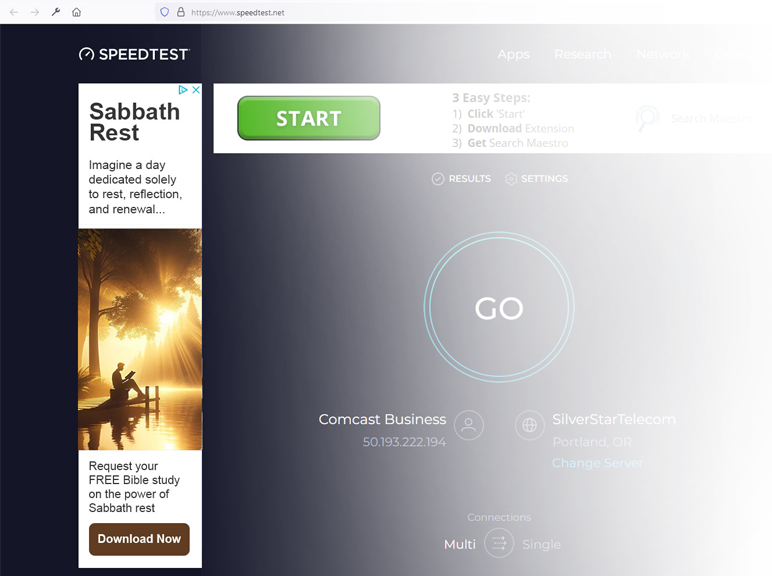
So for example, if they came to the page but didn’t complete the form, and then they go to SpeedTest.net a few days later, you can place a remarketing ad there to remind them. The Google ad network is huge, with hundreds of thousands of websites that run these ads. So there will be lots of places on the internet where they can run across your ad.
You can do the same thing on Facebook and Instagram. If they came to your web page but didn’t fill out the form, you can stay in front of them with repeated ads. You can set it so this ad gets displayed more often to people who came to your website but didn’t take the action you wanted.
You can also change the advertising to invite them to an in-person Bible study, after they’ve completed the form and requested the Bible study guide. Since that’s the next step in the funnel, you can stay in front of them with that offer.
What SermonView Offers for Church Marketing Funnels
I understand that it can be difficult to set it all up. I explained how all this works so you can get the vision for this, but the great thing is we can handle everything for you. You don’t have to do it. You continue to focus on the ministry you do, and we’ll set up the digital marketing to introduce new people to you. You’ll be reaching people right where they are, online, 24 hours a day, 7 days a week, all year long. So let me tell you how SermonView can help you execute your vision for this digital outreach. It’s an amazing program, and I hope you’ll take advantage of it.
CRM Software
Okay, let’s talk about some tools you’ll need. First, as you can imagine, you’re going to have to manage a higher volume of relationships. In addition, parasocial relationships more tenuous. Because of this, you’re going to need some way to manage all this information, some way to keep track of everyone. That’s what a CRM is for. A CRM stands for Customer Relationship Software, like SalesForce, HubSpot, and Zoho CRM. One could argue that eAdventist is actually a CRM, though that is missing a much of features. To be really helpful, you’ll need a way to capture information about each person, and make notes each time you interact with them. Ideally you’ll have the ability to text and email directly from the CRM and set reminders to follow up with someone later on. These are all core functions of a CRM program. You need a CRM to be remain effective, particularly as you grow and develop new relationships.
SermonView has developed a CRM specifically for Adventist evangelism, called InterestTracker. It’s a robust CRM that allows you to segment your list, add notes, & track activity. It’s cloud-based so you can access it anywhere you have internet access, and it centralized so all your users always have the latest information. It offers multiple user roles for your whole team. The user-friendly design and customizable notification settings mean you never miss a new lead or reminder to connect.
It also seamless integrates with all of SermonView’s marketing solutions, like our event pre-registration system and our Bible study lead generation program. The basic features are free and always will be for every church in the North American Division. There are additional paid features, like text messaging and attendance tracking, that are also available. You can learn more about InterestTracker at InterestTracker.org.
Your Church Website
I already mentioned the key role your church website will play in the marketing funnel, but I want to take it a step further. Your church website should be the central, authoritative hub for all your communication, including the spiritual influence messages you’re trying to get out there. Your website should not be about your church, though that information does need to be available. Rather, it should primarily be a venue for evangelistic and discipleship content. If you’re preaching it, put it on the website.
Now this is harder to do if you have an Adventist Church Connect website provided by the NAD. So SermonView offers a website service, Evangelism Websites. It’s focused on reaching new people, but it also has features specifically for your members and leaders, too. It’s built on the most popular platform, WordPress. The service has multiple options, including content management as well as managed digital marketing.
Related to this, you don’t just want a website, but you also want to be visible out in the search engines. We do search engine optimization as part of the website setup. But we also offer Google search engine advertising to keep you visible as an add-on to our website product. The campaign is managed by one of our digital marketing coordinators, and we will run ads for general keywords like “church near me” or “church in Vancouver,” those types of things. We also have a list of keywords we recommend specifically related to Seventh-day Adventist doctrine. So, for example, we’ll run ads when someone in your community searches for “Sabbath,” and we’ll direct them to a page on the website with an article about the Sabbath. Ideally, you’ll have a short video about the Sabbath, in addition to a short article, with a form inviting people to request a Bible study on the topic. We’ll do the same thing for other keywords, like “Second Coming” and “what happens when you die.” Each will send the user to a page on that topic, with a call to action to capture their information so you can continue communicating with them.
Google ads are available at discounted rates when bundled with your church website build.
YouTube advertising
Our newest service that we just launched is YouTube advertising. We can run YouTube ads leading up to an event, or run them systematically throughout the year to raise awareness for your church and help you build parasocial relationships with people in your town. We train you on how to record selfie videos, and we’ll provide coaching and feedback to help you grow in your skills. Once you record it, we’ll handle everything else: video editing, lower third graphics, audio sweetening, call to action slate, rending, uploading to YouTube, and running the ads. It’s all managed by a digital marketing coordinator, to help you get maximum results.
We have a year-long service that we call a pastor branding program. Again, you record the videos, we provide coaching and feedback with every video, and we handle the editing, rendering and uploading to YouTube. Then we’ll set up the campaign. We’ll also give you content ideas, based on what we’ve seen work best in other campaigns.
This program is not cheap. It ranges from $5,000 for the year, to record one video per month, up to $15,000 to record 4 videos per month. A portion of that service fee is allocated to the ad spend, so that includes the cost of running the ads on YouTube. We coach and give you feedback, so you’re improving throughout the year, and we handle all the mechanics of the videos.
Digital Church Funnel Bundles
We wanted to make it easy for you to get started in your church, so we’ve created three bundles to help you. This is a collection of everything you’ll need to move your church into the digital realm.
First, we’ll build you a new outreach-oriented website, with 6 specific landing pages focused on your spiritual messages, like we talked about earlier. Then we’ll set up all the Google search engine ads for the keywords appropriate for your ministry. We’ll also include content management, so we’ll update the website each week for you to keep the content fresh and up to date.
We’ll also get you set up with InterestTracker, so you’ll have a CRM specifically designed for Adventist evangelism. We’ll include subscriptions to every module, including text messaging with 2,000 credits each month and AttendanceTracker. You’ll be able to send bulk text messages to specific segments of your list, or to everyone, and you can use AttendanceTracker to keep track of your weekly worship attendance, in addition to your evangelistic events.
Then, you have some options depending on how much ad budget you want to spend: We can run Facebook and Instagram advertising, helping you reach a wider audience. All these ads will lead back to your website, where you’ll be able to capture information about people who want what you’re offering, whether a Bible study or book or something else. When someone submits a request, it flows automatically into InterestTracker, where you’re alerted to that request so you can begin communicating directly with that interest.
We can also add in a YouTube pastor branding program, so we’ll handle all the mechanics of editing, posting, and running ads for your 90-second sermon summary every week. You’ll be able send us up to 4 videos each month depending on which YouTube plan you want to add, and we’ll provide coaching and feedback on every video so you’ll improve your own skills as the year progresses.
These digital bundles gives you access to 5 different skillsets at SermonView, including video editing, social media advertising, YouTube advertising, and search engine marketing. If you were to hire someone with all these skills to do this for you, that’s a full-time job with valuable skills that would cost you $30-$40,000 minimum. If you were to buy these products individually from SermonView, the cost would be about $25,000. By bundling the resources, you can get a comprehensive, recurring digital marketing funnel running throughout the year, with plans starting at $5,000 going all the way up to $19,000 annually.
A large portion of the cost is the actual ad spend, which we include with these program to give you a full package price. Every month we’ll be running ads across Google search plus you can add other programs like Facebook & Instagram, plus YouTube, depending on your church’s budget and growth goals.
We run all of these campaigns independent of each other all the time, but bundling all of these resources like this is a brand new program that we just started offering a couple of months ago. Because it’s new, we’re limiting participation initially to 5 churches, so we’ll be able to work out some of the production kinks. You’ll be one of the first churches to begin the digital transformation at a high level and implement these digital marketing funnels. I’ve talked with a couple of conferences who are offering funds for this, so even if it feels like a lot of money, your conference may be willing to subsidize the cost. In fact, if you talk with your conference leader and they have questions, I’m happy to personally talk with them to help them catch the vision of what you want to do in your community.
Contact us to learn more about the 3 Digital Church Funnel options and see which one is right for your church. We can also get you set up with more information to take to your church board, or to present to your conference if asking for subsidy assistance.
Reaching the Next Generation.
The digital transformation is happening all around us, whether we like it or not. And churches who don’t embrace this change are going to die, as the digital natives turn their back on our analog way of doing church. SermonView is at the cutting edge of powering the digital transformation, and we’d love to support you as your church makes this transition.
We are in the midst of a rapid, radical reordering of society, a digital transformation. Most churches remain an analog island in a digital sea, and if we don’t embrace this digital transformation, we are going to die. We haven’t lost the young adult generation. We never had them, because the way we do church in these analog ways are completely foreign to the digital natives.
When we embrace this digital transformation, however, it blows our ministry out beyond the walls of the church. We can become significant influencers encouraging people from all walks of life to take the next step closer to Jesus. We’ll go where the people actually are, and make a real difference in the community. I believe the digital transformation can truly change the world, as God works through us to reach new generations for Christ.

